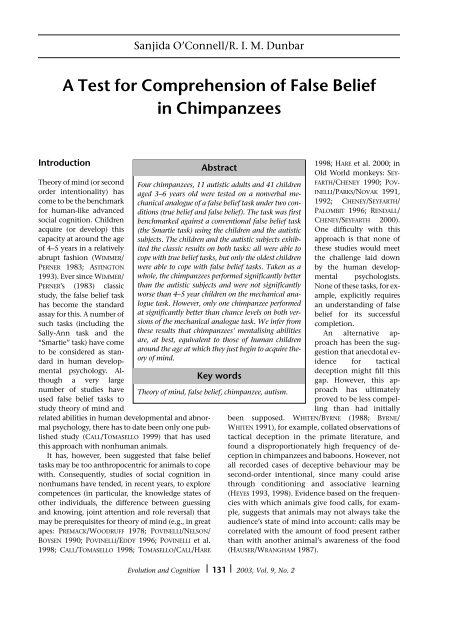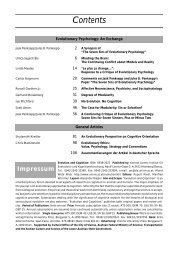Contents - Konrad Lorenz Institute
Contents - Konrad Lorenz Institute
Contents - Konrad Lorenz Institute
Create successful ePaper yourself
Turn your PDF publications into a flip-book with our unique Google optimized e-Paper software.
Sanjida O’Connell/R. I. M. Dunbar<br />
A Test for Comprehension of False Belief<br />
in Chimpanzees<br />
Introduction<br />
Theory of mind (or second<br />
order intentionality) has<br />
come to be the benchmark<br />
for human-like advanced<br />
social cognition. Children<br />
acquire (or develop) this<br />
capacity at around the age<br />
of 4–5 years in a relatively<br />
abrupt fashion (WIMMER/<br />
PERNER 1983; ASTINGTON<br />
1993). Ever since WIMMER/<br />
PERNER’s (1983) classic<br />
study, the false belief task<br />
has become the standard<br />
assay for this. A number of<br />
such tasks (including the<br />
Sally-Ann task and the<br />
“Smartie” task) have come<br />
to be considered as standard<br />
in human developmental<br />
psychology. Although<br />
a very large<br />
number of studies have<br />
used false belief tasks to<br />
study theory of mind and<br />
related abilities in human developmental and abnormal<br />
psychology, there has to date been only one published<br />
study (CALL/TOMASELLO 1999) that has used<br />
this approach with nonhuman animals.<br />
It has, however, been suggested that false belief<br />
tasks may be too anthropocentric for animals to cope<br />
with. Consequently, studies of social cognition in<br />
nonhumans have tended, in recent years, to explore<br />
competences (in particular, the knowledge states of<br />
other individuals, the difference between guessing<br />
and knowing, joint attention and role reversal) that<br />
may be prerequisites for theory of mind (e.g., in great<br />
apes: PREMACK/WOODRUFF 1978; POVINELLI/NELSON/<br />
BOYSEN 1990; POVINELLI/EDDY 1996; POVINELLI et al.<br />
1998; CALL/TOMASELLO 1998; TOMASELLO/CALL/HARE<br />
Abstract<br />
Four chimpanzees, 11 autistic adults and 41 children<br />
aged 3–6 years old were tested on a nonverbal mechanical<br />
analogue of a false belief task under two conditions<br />
(true belief and false belief). The task was first<br />
benchmarked against a conventional false belief task<br />
(the Smartie task) using the children and the autistic<br />
subjects. The children and the autistic subjects exhibited<br />
the classic results on both tasks: all were able to<br />
cope with true belief tasks, but only the oldest children<br />
were able to cope with false belief tasks. Taken as a<br />
whole, the chimpanzees performed significantly better<br />
than the autistic subjects and were not significantly<br />
worse than 4–5 year children on the mechanical analogue<br />
task. However, only one chimpanzee performed<br />
at significantly better than chance levels on both versions<br />
of the mechanical analogue task. We infer from<br />
these results that chimpanzees’ mentalising abilities<br />
are, at best, equivalent to those of human children<br />
around the age at which they just begin to acquire theory<br />
of mind.<br />
Key words<br />
Theory of mind, false belief, chimpanzee, autism.<br />
Evolution and Cognition ❘ 131 ❘ 2003, Vol. 9, No. 2<br />
1998; HARE et al. 2000; in<br />
Old World monkeys: SEY-<br />
FARTH/CHENEY 1990; POV-<br />
INELLI/PARKS/NOVAK 1991,<br />
1992; CHENEY/SEYFARTH/<br />
PALOMBIT 1996; RENDALL/<br />
CHENEY/SEYFARTH 2000).<br />
One difficulty with this<br />
approach is that none of<br />
these studies would meet<br />
the challenge laid down<br />
by the human developmental<br />
psychologists.<br />
None of these tasks, for example,<br />
explicitly requires<br />
an understanding of false<br />
belief for its successful<br />
completion.<br />
An alternative approach<br />
has been the suggestion<br />
that anecdotal evidence<br />
for tactical<br />
deception might fill this<br />
gap. However, this approach<br />
has ultimately<br />
proved to be less compelling<br />
than had initially<br />
been supposed. WHITEN/BYRNE (1988; BYRNE/<br />
WHITEN 1991), for example, collated observations of<br />
tactical deception in the primate literature, and<br />
found a disproportionately high frequency of deception<br />
in chimpanzees and baboons. However, not<br />
all recorded cases of deceptive behaviour may be<br />
second-order intentional, since many could arise<br />
through conditioning and associative learning<br />
(HEYES 1993, 1998). Evidence based on the frequencies<br />
with which animals give food calls, for example,<br />
suggests that animals may not always take the<br />
audience’s state of mind into account: calls may be<br />
correlated with the amount of food present rather<br />
than with another animal’s awareness of the food<br />
(HAUSER/WRANGHAM 1987).








